The Music of Bhutan is one of the most important culturally binding influences that have for generations been the source of transmitting knowledge, history, nationalism and spirituality. Bhutanese Music can be classified into various genres and themes, ranging from traditional, folk, religious songs to B-Pop music.
However, it was not until the 1960s that the electronic instruments were introduced into the music of Bhutan. Hence, it was the spiritual and folk music that dominated the musical landscape of the country for many years. Today modern music, also called the Rigsar is popular amongst the youth of the country, but the old music genres are far from being extinct.
The music of Bhutan can be distinctly divided into traditional and modern music. The traditional music includes folk and religious music. Let us take a look below at the different music of Bhutan.
Traditional Music - Folk and Religious Bhutanese Music
1. Bhutan Folk Music
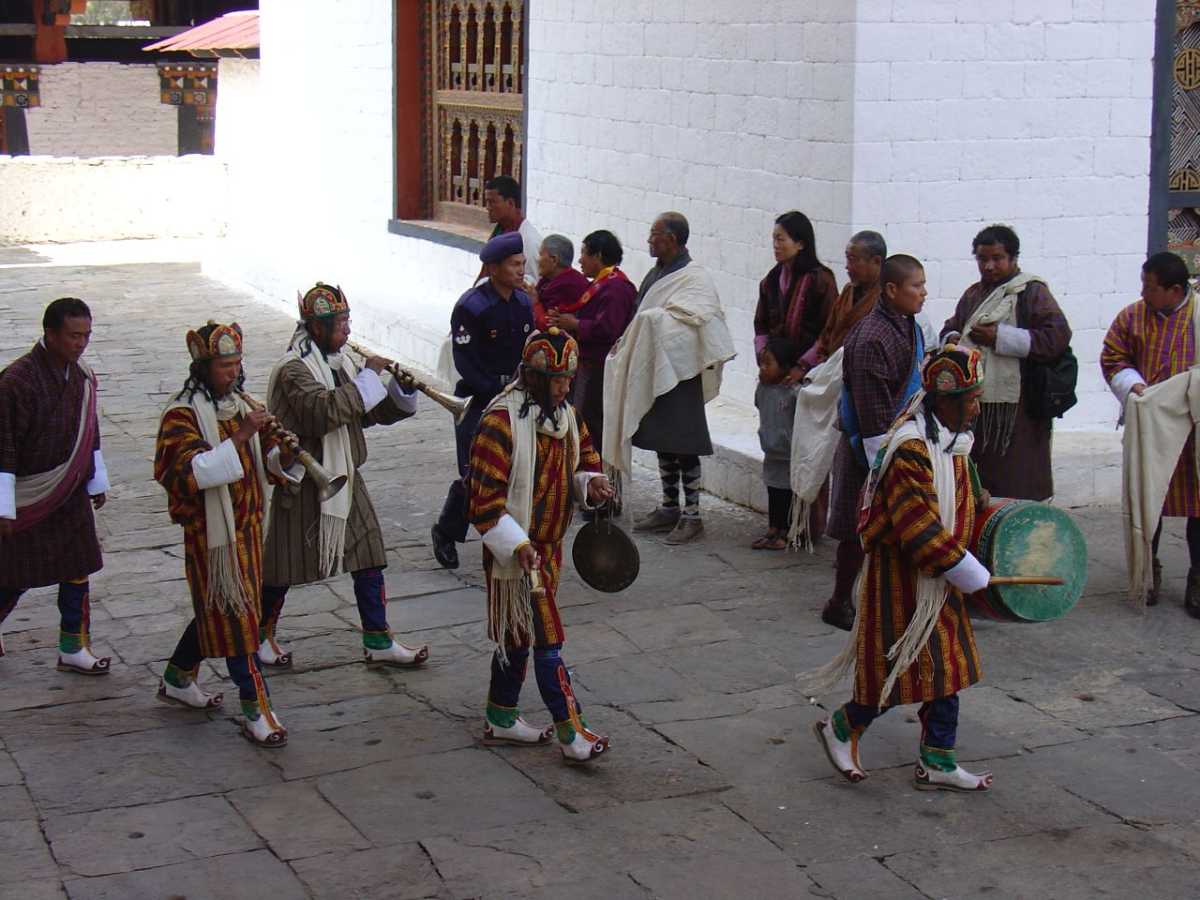
The folk music of the country is very local in flavour and differs with subtle variations from village to village or region to region. The lyrics of the folk music are also in Choke or Dzongkha (or Bhutanese). The folk music is also usually accompanied by dance and performances as enacted during the Tsechus. The dancers adorn beautiful costumes with masks and the music plays an important role in depicting the various characters, such as the demons, heroes, animals and so on.
The mastery of folk music is a combination of talent and disciplined practice as it well-known that some of the subgenres of folk music are extremely difficult to sing. The facial expression, the pitch of voice and the overall gestures in performance are all woven together to derive the best out of folk music and performances. There are many further classification and subtypes of folk music.
a. Boedra
- Boedra is a vital subgenre of the folk music of Bhutan. Boedra originated out of the Tibetan court music and was spread by the Boed Garps who travelled from village to village on official tours. The Boedra songs are usually sung in a circle and the tunes can be danced too. The Boedra music is relatively easier to sing when compared to another subgenre of folk music, the Zhungdra.
- Instruments: The musical instruments that are often used for the composition of a Boedra song include the chiwang (fiddle), dramyin and the lingm (flute).
- Zhungdra is one of the most important subgenres of folk music in Bhutan. It was developed in the 17th century and is usually played in Paro, Punakha, Thimpu and Ngalop regions. Zhungdra is also considered as one of the most difficult genres to execute. Even trained singers find it challenging to sing because of the extended vocal tones that are sung in a complex pattern. The singing is centred on usually a simple instrumental tune.
- Though Zhungdra is folk music, the distinction between folk and religious music is very fine. The Zhungdra is also sung by artists who stand in a line facing the altar and lamas or the guests. Zhungdra are songs that can also be dance-oriented and hence can be both sung and performed as well.
- The Zhungdra is said to have originated in the Dzongs or the centres of administrative, civil and religious activity. Literally meaning the Melody of the Centre the Zhungdra then spread from village to village.
- Performed often during the tsechus, the pair of zhey and zhem are vocal songs that are elaborately choreographed. The zhey, made of quick steps is performed by men, while the zhem is done by women. The zhey is very region-specific and have been composed in different areas of Bhutan. However, both the zhey and zhem have some elements of Zhungra and Boedra in terms of their melody, tune and dances.
- Zheys are in fact, the longest songs in Bhutan and they are usually sung during festivals. Shortened versions of zheys are also sung on many other local occasions.
- There are both major and minor zheys. Some of the major zheys include the Goen Zhey, Nub Zhey, Wang Zhey and Woochupai Zhey. The minor zheys are the Auley, Locho, Bonghur and Miritsemoi Zhey.
- The Nub Zhey is the longest zhey made up of 25 different episodes, each more than five minutes long. The Goen Zhey is one of the most important zhey compositions and is believed to have originated when the people of Goen living in Gasa offered the dance form to the founder of Bhutan Zhabdrung Ngawang Namgyal in 1616. The Wang Zhey originated in Thimphu from a commoner living in the Wang Valley and is considered one of the endangered performances in the musical repository of Bhutan. The 2011 Royal Wedding witnessed a number of zhey performances, including the major and minor zhey.
2. Tsangmo - Literary Genre
Tsangmo is also a popular genre of the music of Bhutan. Sung in couplets, the Tsangmo can also be sung in a conversational style, with a call followed by a reply. It is also often used in competitions. The first lines describe a situation or scenario and the replies dwell on the emotions of love, abuse, hate, ridicule and more. The Tsangmo unlike most of the other music genres can only be sung and not danced to. The Tsangmo is also usually structured well consisting of four lines with two couplets.3. Lozey
Lozey is very similar to Tsangmo though they also have their differences. Lozey literally means ‘ornaments of speech’ and like Tsangmo is also a call and reply musical exchange. The theme of the songs revolves around traditions, costumes, customs and literature. These are sung in the vernacular language and the ballads vary from region to region. However, unlike the Tsangmo, the Lozey is not well structured and the songs can be both short and long. The Lozey too is not a musical parody associated with dance.4. Religious or Spiritual Music
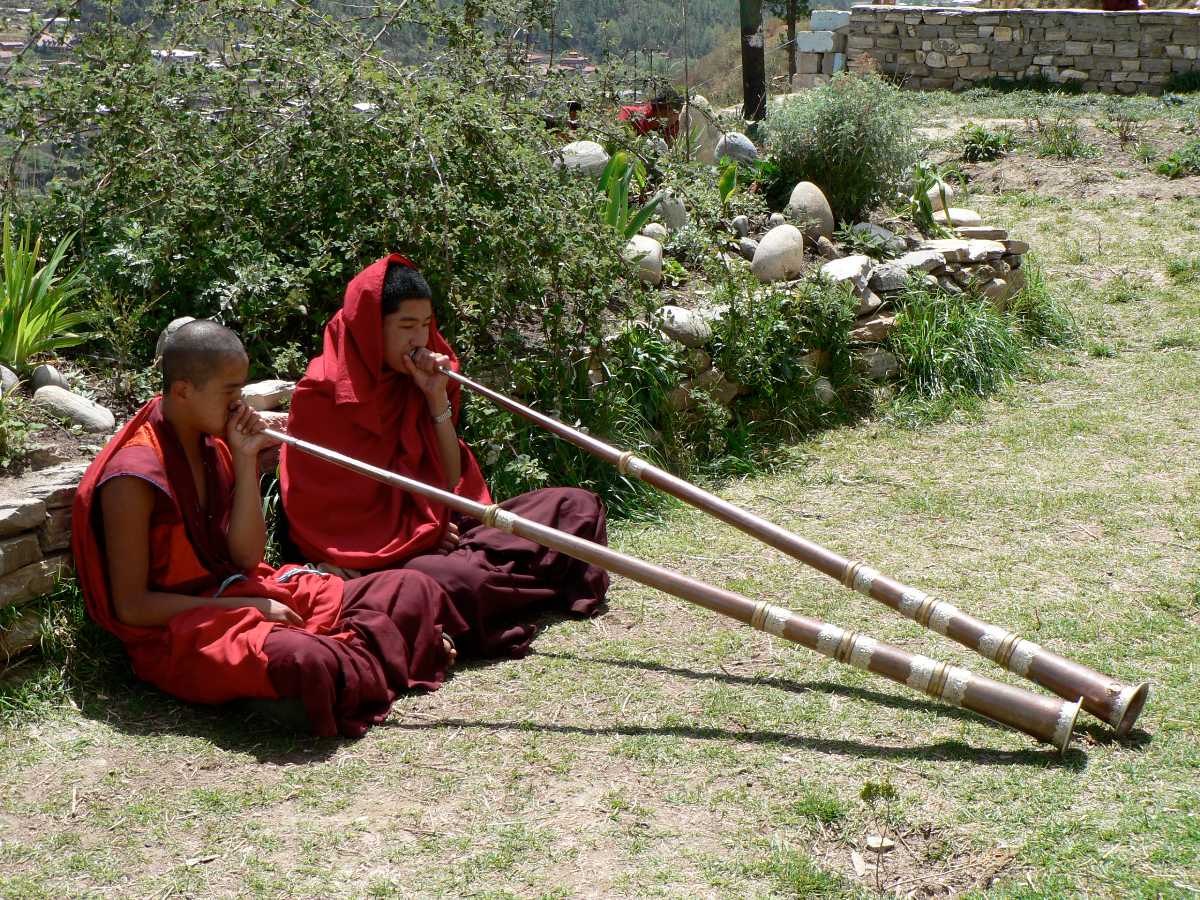
Bhutan is predominantly a Buddhist nation and the religious music of the country is deeply reflective of the Buddhist teachings and rituals. The biographies of saints, as well as, chants make up the lyrical substance that is often enacted through dance accompanied by masks and costumes. The monastic music is in fact, Bhutan’s most identifiable music throughout the world and is a wonderful sight to behold when sung and performed by the monks.
The Cham dance is a religious performance and is also a part of the Tibetan Buddhist culture. The founder and Lama of Bhutan Zhabdrung Ngawang Namgyal are believed to have introduced the masked dances in Bhutan that are performed mainly during the Tsechus or festivals celebrated in monasteries. The religious music is hence almost synonymous with the various Cham dances that are infused with spiritual texture and tone.
The teachings of Buddha, the victory of good over evil, enlightenment and purification of the soul are some of the central themes during a Cham dance. The religious songs are written in Choke, which is the classical language of Tibet.
Instruments: The musical instruments used are the drums and cymbals, except during the Dramyin Cham which is performed using the traditional lute.

Source
Modern Music of Bhutan
5. Rigsar
The modern popular music genre that began in the 1960s is referred to as Rigsar. The main difference between traditional music and Rigsar is the use of electronic instruments and the use of vernacular language. The Rigsar features mostly in films and television of Bhutan and its influence is also seen on Bollywood Indian music, for example, the song ‘Sayonara’ is a rigsar version called Zhendi Migo.The Rigsar music, however, saw a decline in popularity for a few years due to the use of repetitive themes and tunes. But from 1980s onwards the rigsar music found its importance once again after introducing fusion with English, Indian and Nepalese music. Rigsar is the music that is most common in the streets and daily lifestyle of the people. It is also more popular with the youth of the nation who like the fast-paced and easier to sing songs. The theme of Rigsar music primarily revolves around love and boy meets girl scenarios.
6. B-Pop - Popular Music
The most recent addition to the glorious musical history of Bhutanese music is B-pop. The style adopted by the local M-Studio in Thimphu has produced several hits in a short span of time. Some of the most popular songs include the Tharingsa and Yonphula.The classification of Bhutanese music can also be done on the themes of the songs. These would be:
1. Songs by lamas for prayer and worshipHence, where traditional music, which includes the religious and folk music cover almost all the themes, modern-day Rigsar music’s primary focus is love songs.
2. Religious songs
3. Songs praising the king
4. Songs praising the country
5. Songs revolving around happiness
6. Love songs
7. Sorrowful songs
8. Songs of good wishes
Musical Instruments
Like the musical compositions of Bhutan, the musical instruments too have a historical significance. In fact, the traditional music of Bhutan gets its true essence from its musical instruments. The electronic instruments were introduced as late as in the 1960s in Bhutan. Hence, traditional musical instruments have a deep and entrenched role to play. Some of the important musical instruments of Bhutan include:1. Drangyen or Dranmryen
This is a long lute which is made up of seven strings. The drangyen is the most popular and oldest musical instrument of Bhutan. Its sound and melody are difficult to master. However, besides its music, the drangyen is also unique in its appearance. Its head is designed in the shape of a sea monster to wade off evil spirits, and its body is delicately carved. The cavity is well balanced for the perfect enhancement of sound. The drangyen is, in fact, an integral part of the religious and traditional music of Bhutan.The Rigsar Drangyen is a modern version of the traditional instrument. It has eight strings instead of six.
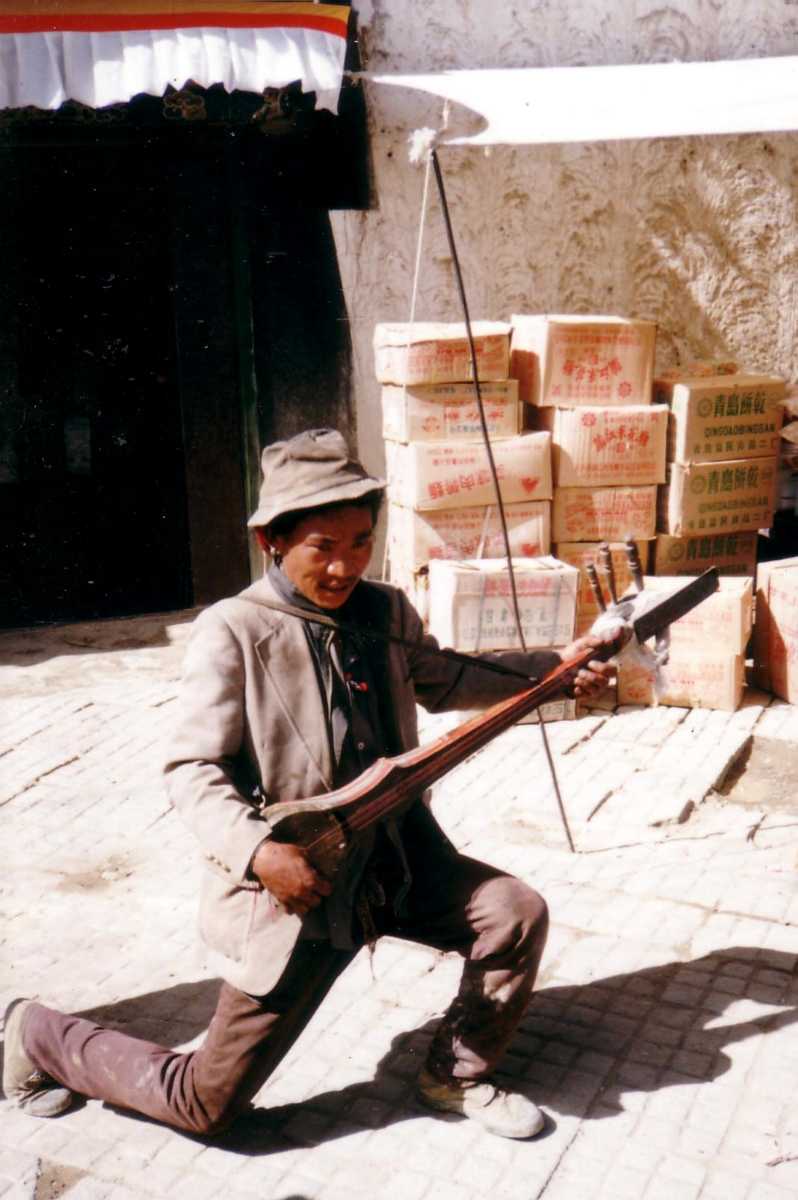
Source
2. Chiwang
Also called the Pewang is a fiddle made from a buffalo, cow or ox horn. The chiwang is played with a bow made from dried bamboo and horsetail. Both the drangyen and chiwang are stringed instruments.3. Dong Lim
There are many kinds of flutes used in Bhutanese music. The Dong Lim is a bamboo flute with six finger holes and a mouth hole. It is also called the badui-pa jing or the cow herder’s instrument in Kheng.4. Ba-Jing
Another popular flute called Ba-Jing produced several musical notes through its upper and lower finger holes. This a simple cylindrical instrument made from bamboo.5. Aungli
This wind instrument is made from the horns of ox or buffalo. There is a hole at the end for the air to pass and besides its use in music, the aungli is also blown every morning and evening for the cattle to know when to get and when to return to their shed.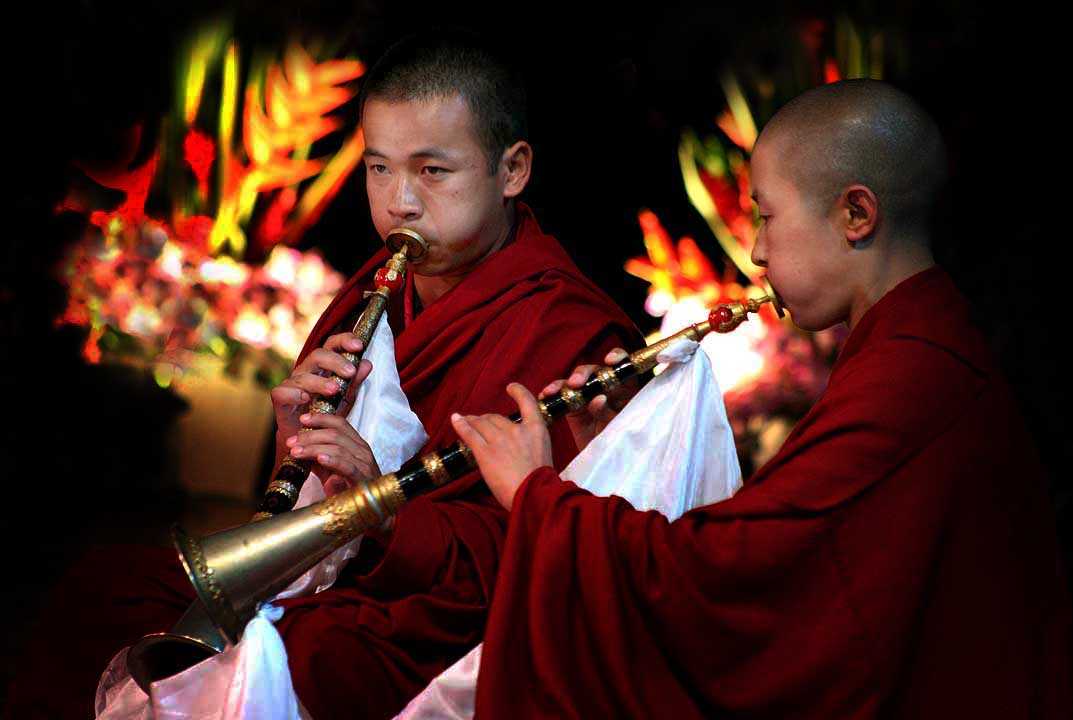
6. Pay Wang
This is a smaller flute when compared to the other flutes in Bhutan. It has six central finger holes and is not more than 13 inches in size.7. Chikang
Chikang is a mouth organ where the elastic or tissue is held in between a piece of bamboo. It is meant to be held in the left hand where the right-hand pull at the instrument back and forth to create music.8. Kapka Ma
Made from bamboo, this vertical cylindrical instrument is hollowed out in the middle. It can be made of many bamboo sticks and is also found in the fields of Bhutan besides its musical use.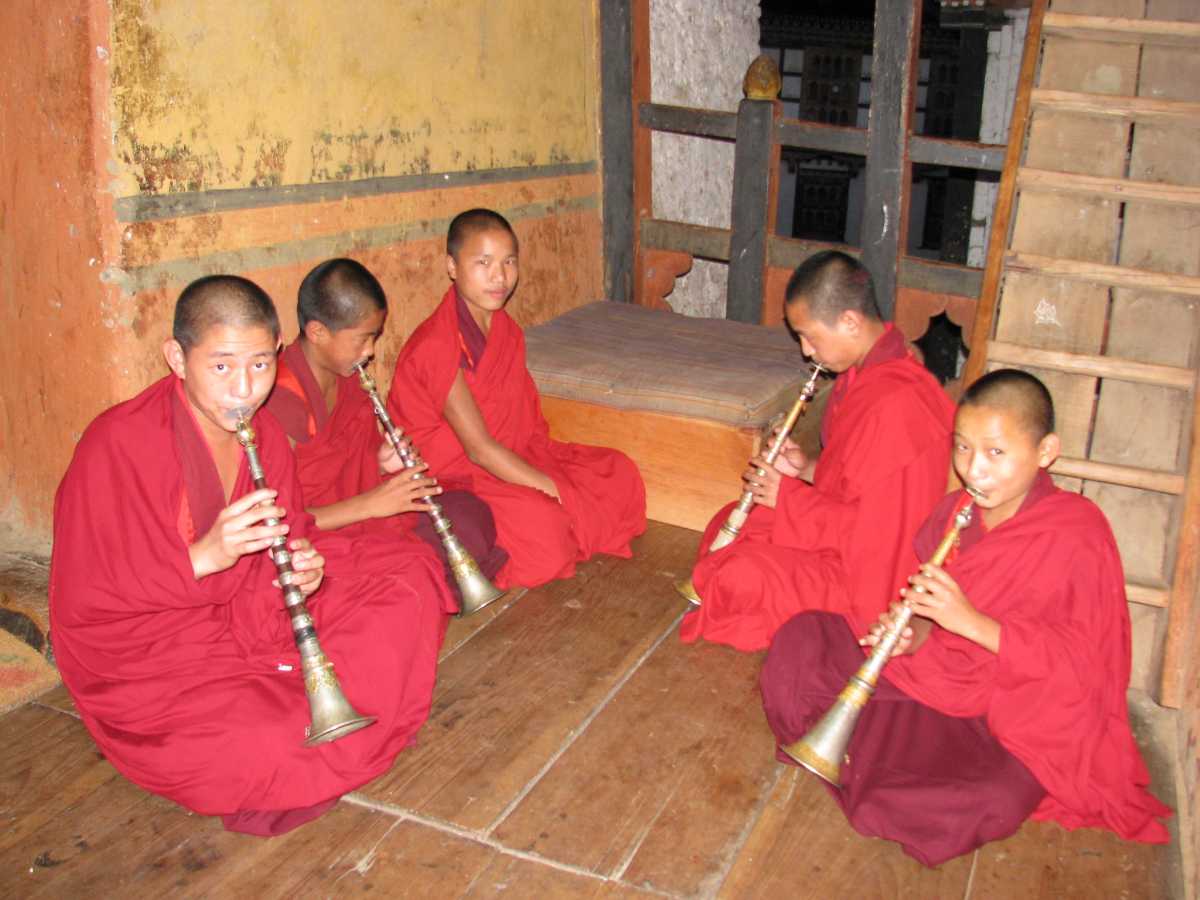
Source
Singers and Songs
- Some of the most distinguished singers and musicians of the traditional genre are, Kheng Sonam Dorji, Aum Thinlem, Aup Dawpey, Aum Tshewang Lham, Aup Tsheten Dorji, Aup Dengo, Aum Sedy and more.
- Modern music livewires include Bhutan’s popular music star Shera Lhendup, Norling Drayang etc.
- Some of the popular traditional folk songs of Bhutan are, Chumo la Dingsho, Chenrezig Prayer, Tabu Cholay Mawa, Pang Lu Shawa, Lungten Zampa, Samyegi Salamo, Jaza Boe la Medro and many more.
- There are many other traditional musical instruments used in Bhutan, such as the yang-chen, dharu (drum), choe-drum, dungkar (shell trumpet), kanling (shawm), tingsha, rim(cymbal), kongtha(harp), arka(bells) as well as the naturally found yangkali which is a pod of seeds that is shaken to create music.
Preservation of Musical Heritage - MBRC Bhutan
The traditional music has seen a decline in usage and composition over the last few decades. To ensure that the musical, cultural heritage of the nation is retained and sustained a number of institutes and organizations in the recent past have taken it upon themselves to help in the awareness, training and spread of traditional music. Some of the institutes that nurture and are preserving the traditional music are the Royal Academy of Performing Arts (RAPA), Royal University of Bhutan Institute of Language and Cultural Studies (ILCS), Music of Bhutan Research Centre (MBRC), The Bhutan Foundation and more.Bhutanese music is a rich collection of songs that have been song over many generations. The skill of singing has also been passed down through the ages that make the music of Bhutan a cultural heritage, as well as, an aesthetic and artistic body of work. The modern popular music is in line with the preferences of the youth and the advent of films and television. However, the collective troupe of the musical significance and work in Bhutan is splendid and almost surreal.
